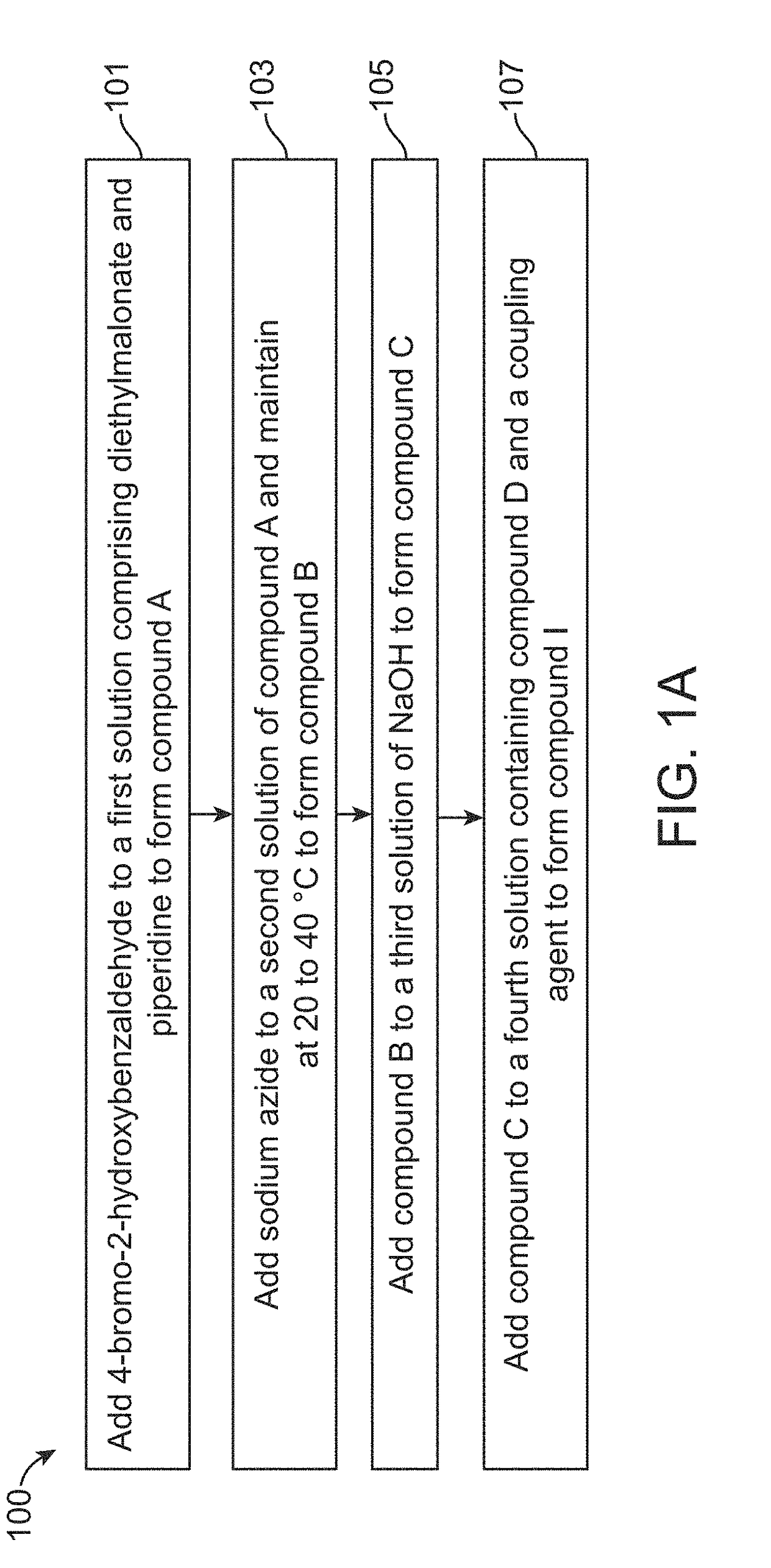Flourescent exomarker probes for hydrogen sulfide detection
a fluorescent exomarker and probe technology, applied in the field of fluorescent exomarker probes for hydrogen sulfide detection, can solve the problems of limited diagnostic tools and no prior art report a potent probing device for mapping endogenous h2s formation in cancer cells over normal cells
- Summary
- Abstract
- Description
- Claims
- Application Information
AI Technical Summary
Benefits of technology
Problems solved by technology
Method used
Image
Examples
example 1
of Mito-HS
[0066]A solution of 4-bromo-2-hydroxybenzaldehyde (1.0 g, 4.97 mmol) was prepared by adding in 20 mL of ethanol. Diethylmalonate (955 mg, 5.97 mmol) and piperidine (1.27 g, 14.92 mmol) were added to it followed by continuous stirring for 3 hours at room temperature. Ethanol was evaporated after competition of the reaction. The residue obtained was dissolved in 2N HCl and extracted with ethyl acetate The extracted organic layer was washed with water and brine solution followed by drying over anhydrous sodium sulfate. The organic layer was kept in reduced pressure to get concentrated to obtain white colour solid product (1.20 g, 81.63%), named as compound A.
[0067]The yield for the above synthesis was 98.10%, determined by liquid chromatography-mass spectrometry (LCMS). ‘H and’3C NMR were performed for compound A. 1H-NMR (400 MHz, DMSO-d6): δ 8.76 (s, 1H); 7.86 (d, 1H, j=9.08 Hz); 7.78 (s, 1H); 7.62-7.60 (dd, 1H, j=6.88 Hz); 4.30 (q, 2H); 1.30 (q, 3H); 13C-NMR (100 MHz, DMSO-...
example 2
of Endogenous H2S Selectively in Cancer Cells
[0074]Human cervical cancer cells (HeLa), breast cancer cells (MDA-MB-231), prostate cancer cells (DU 145) and 3T3-L1 fibroblast cells were cultured in DMEM high glucose media supplemented with 10% fetal bovine serum, 1% Penstrep, 0.2% Amphotericin B. The cells were grown overnight at 37° C. incubator with 5% CO2. HeLa, MDA-MB-231, DU 145, and 3T3-L1 cells were seeded at a density of 0.3×106 cells in 35 mm dish and kept overnight. The probe Mito-HS prepared in Example 1 was dissolved in 0.2% DMSO to make a stock concentration of 10 mM. The cells were treated with 5 μM of Mito-HS for 15 min. 300-550 nm excitation light was used to measure its fluorescence properties. Images were acquired using Zeiss Fluorescence Microscope (A1 Axiovert) with ×40 objective lens.
[0075]UV-Vis and fluorescence spectroscopy was studied and changes of Mito-HS was recorded in variable concentrations of Na2S (0-200 μM) in PBS buffer solution containing 0.2% of DMS...
example 3
ty Study of Mito-HS in Cellular Milieu
[0077]Fluorescence responses of Mito-HS (5 μM) in the presence of various biologically important analytes such as H2S, cysteine (Cys), H2O2, NaNO2, Cu(OAc)2, Zn(OAc)2, FeSO4, FeCl3, Na2CO3, GSH, and ascorbic acid (AA) NO, Na2S2O4 in aqueous solutions (in PBS, 0.2% DMSO, pH=7.4) at 37° C. were studied as shown in FIG. 5. Excitation wavelength was set at 380 nm and excitation and emission slit widths both set at 3 nm. Error bars were obtained from triplet experimental data. It was observed that none of the analytes showed considerable fluorescence change other than H2S. So, the experiment supported the proposed concept of using Mito-HS to track cellular H2S over other competing substances such as thiols.
PUM
 Login to View More
Login to View More Abstract
Description
Claims
Application Information
 Login to View More
Login to View More - R&D
- Intellectual Property
- Life Sciences
- Materials
- Tech Scout
- Unparalleled Data Quality
- Higher Quality Content
- 60% Fewer Hallucinations
Browse by: Latest US Patents, China's latest patents, Technical Efficacy Thesaurus, Application Domain, Technology Topic, Popular Technical Reports.
© 2025 PatSnap. All rights reserved.Legal|Privacy policy|Modern Slavery Act Transparency Statement|Sitemap|About US| Contact US: help@patsnap.com



